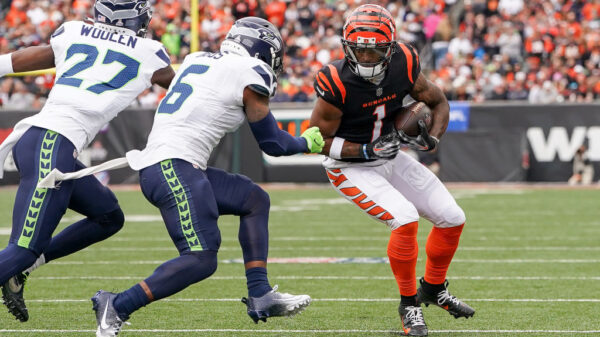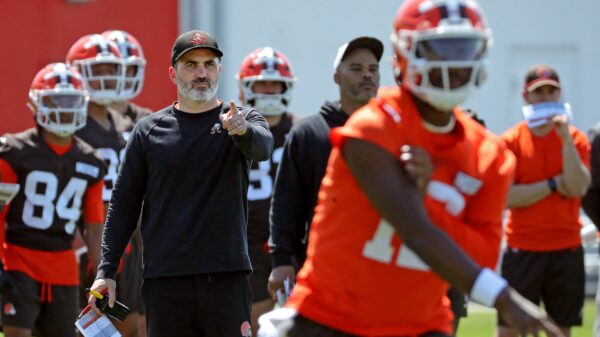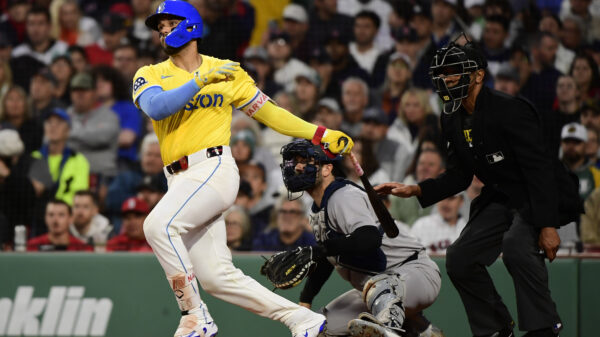Part of the beauty of the draft is that while it answers some of our offseason questions, it opens up a slew of new ones in the process. Why did they take him that high? Where does the coaching staff plan to use him? What does this mean for the future of the franchise?
We don’t have the answers right now, but it’s fair to make an educated guess based on where a player was projected to fall and how they fit a certain roster’s needs. Here’s the grade for every AFC team this weekend in Vegas.
Baltimore Ravens Draft Grade
The best pick of the night, arguably for any team, was the Ravens selecting safety Kyle Hamilton with the 14th pick of the first round. A top-five talent, it seemed that Hamilton’s slide had to do with a desire from other franchises to add at more “valuable” positions rather than his ability. Paired with newly acquired Marcus Williams, Baltimore should have a fearsome secondary. The fun didn’t stop there; the selections of offensive lineman Tyler Linderbaum (via the Marquise Brown trade), edge David Ojabo and defensive tackle Travis Jones were all high-upside selections that didn’t require the team reaching or giving up more assets. Even the fourth round was a win; the tight end duo of Charlie Kolar and Isaiah Likely should (likely) produce at least one starting-caliber tight end. Simply an amazing weekend for Baltimore.
Grade: A
Buffalo Bills Draft Grade
Despite having one of the NFL’s premier defenses, the Bills traded up to add Kaiir Elam at cornerback, which tends to happen when Patrick Mahomes kills your season in under thirty seconds. The rookie offers an immediate upgrade across from Tre’Davious White. Buffalo’s best pick was in the second round with James Cook, a dynamic pass-catching halfback that could quickly become a popular pick in fantasy football drafts. However, additional offensive and defensive line help were passed over for less essential needs, so it’s hard to call this a home run draft. I should mention: Landing “The Punt God,” Matt Araiza, in the sixth round isn’t just a good football fit; I fully expect him to become an urban legend amongst Bills Mafia by October.
Grade: B
Cincinnati Bengals Draft Grade
When your team has Joe Burrow and Ja’Marr Chase, offense should be the least of your worries. The Bengals spent their first three picks of the draft on defensive players, focusing mainly on the secondary. Daxton Hill is defined as a safety but can play all over the field, while cornerback Cam Taylor-Britt gives defensive coordinator Lou Anarumo another weapon to slow down offenses. Additionally, with Jessie Bates entering the last year of his current contract, having depth to fill in could prove very useful next season. Zachary Carter brings Hill’s level of versatility to the defensive line, where he can generate pressure even from the interior. Overall, Cincinnati went into draft day with a clear-cut plan and executed.
Grade: A-
Cleveland Browns Draft Grade
The Browns, having dealt a bevy of high draft picks in the Deshaun Watson trade, entered the weekend with limited draft capital and left with nine new players. They moved back twice on Day 2, including a deal with the Texans that netted them an additional third-round selection and two more in the fourth. However, the value of the players they selected was mixed. Cornerback Martin Emerson and edge Alex Wright, both selected in the third round, should provide immediate help. However, for a team clearly trying to win a Super Bowl in the near future, it may have made more sense to move up or stay put and select a difference-maker at wide receiver. Third-rounder David Bell is solid, but he’s not the most athletic prospect and may struggle to establish himself on the depth chart as a rookie with similar receivers in front of him. Nabbing another speedster in the second or third would have been nice, as would center depth following the release of J.C. Tretter.
Grade: B
Denver Broncos Draft Grade
Like Cleveland, Denver entered the draft having sacrificed most of their selections for a new quarterback, Russell Wilson. Also like the Browns, the Broncos were willing to trade back, including making a savvy move with the Colts to nab a 2023 third-round pick. I loved the team’s first selection in the second round of linebacker Nik Bonitto. The former Oklahoma Sooner needs some refinement to his game, but he has a clear-cut role from day one as a stopper in the run game. Similarly to Bonitto, the team’s fourth-round pick, Damarri Mathis, is lanky, fast and physical, ideal traits for an outside cornerback. Where I felt the value was missing was the team’s third-round choice, tight end Greg Dulcich. Dulcich is one of the better prospects at his position in this class, but I struggle to see the urgency to add him, given the available tight end talent that was still on the board in the fourth round (and Dulcich’s struggles as a blocker). In what is shaping up to be an AFC West arms race, missing out on a potential starter at linebacker or tackle feels short-sighted.
Grade: B
Houston Texans Draft Grade
Look up and down at the Texans’ draft haul, and you’ll see a diverse array of offensive weapons and defensive stoppers with nary a reach to be found, outside of taking guard Kenyon Green with the 15th overall pick. For a team with needs literally everywhere, general manager Nick Caserio was aggressive in upgrading wherever he saw fit, trading up and down multiple times. Derek Stingley Jr. and Jalen Pitre give the Texans some semblance of an identity on defense, while “flashy” mid-round selections of John Metchie III and Dameon Pierce, two of my favorite prospects this year, should allow for the team to figure out if Davis Mills is their franchise quarterback going forward. Even though there was nowhere to go but up, Houston should be elated with their newest additions.
Grade: A-
Indianapolis Colts Draft Grade
The Colts may have entered the draft Thursday without a first-round pick, but they sure made the most of their three selections on Day 2. Let’s start with their second-rounder, Alec Pierce. The former Cincinnati Bearcats wide receiver is as dependable as they come for a college prospect, and projects as a safety blanket for Matt Ryan and whoever replaces him down the road. Athletic TE Jelani Woods was great value in the third round, as I think he could be considered the best tight end in this draft class when we look back in a few years. Later in the third, Indy took offensive tackle Bernhard Raimann, a project that could become an o-line mainstay if developed properly; given the Colts’ recent success up front, I’d count on it. Finally, the team traded up to grab safety Nick Cross, a second-round talent that steps into an area of need in the secondary. This was an impressive showing for the Colts, as it’s hard to knock them for any of their decisions.
Grade: A
Jacksonville Jaguars Draft Grade
I’m not going to waste your time offering another doom-and-gloom analysis of Travon Walker. It isn’t the move I would have made, but this is still a top-five talent with arguably the biggest ceiling of any prospect in this draft class. Aidan Hutchinson is more of a day one contributor, but Walker’s athletic upside made it tough for anyone to pass on him. The number one overall pick will be the face of Jacksonville’s improved defense, alongside Josh Allen and fellow first-round pick Devin Lloyd, who was a steal at the end of the first round. However, I would have liked to see more of an effort to help Trevor Lawrence. New talent at tight end and wide receiver, despite offseason signings, was needed but not addressed in the draft. Taking linebacker Chad Muma in the third felt like major overkill after selecting Lloyd as well, although I did love the selection of center Luke Fortner. The Jags aren’t one player away from meaningful football, but their picks past Round 1 didn’t always seem to reflect that.
Grade: C+
Kansas City Chiefs Draft Grade
Kansas City’s front office has gotten rave reviews post-draft, and it isn’t hard to see why. The Chiefs didn’t go the expected route of wide receiver in Round 1, instead trading up to get Trent McDuffie. The star cornerback out of Washington was projected to be selected as early as pick #11, but a run on pass catchers allowed his stock to drop. With their second first rounder, K.C. selected George Karlaftis, a sneaky-athletic edge that can provide production right away on the defensive line. Finally, the team found Tyreek Hill’s replacement in the second round with Skyy Moore, a speedster tailor-made for the Chiefs’ offense. Third rounder Leo Chenal can also help a mediocre run defense at linebacker. In total, that’s a lot of potential for Andy Reid to work with.
Grade: A
Las Vegas Raiders Draft Grade
Despite it being on their home turf, the Raiders weren’t big players at the draft. The Davante Adams trade, which cost them their first and second round picks this year, meant that Las Vegas would make their first selection in Round 3. On the bright side, they took one of the best linemen in the class, Dylan Parham. The Raiders needed help in the trenches, and Parham can fill in almost anywhere on the offensive line. I also liked seeing the team double-dip at defensive tackle with Neil Farrell Jr. and Matthew Butler. However, with such limited resources available, it’s difficult to justify Las Vegas taking running back Zamir White in the fourth round, even after declining Josh Jacobs’ fifth-year option.
Grade: B
Los Angeles Chargers Draft Grade
Zion Johnson is talented enough to be a future Pro Bowler, which justifies L.A. using a first-round pick on the offensive line for the second year in a row. Unlike the Jaguars, the Bolts understand that Justin Herbert’s health and success is priority number one. JT Woods is fine in Round 3, but another cornerback may have been better. Sixth round pick Jamaree Salyer was a starting lineman in the SEC who can provide depth across the O-line. Failing to add any receiver is a missed opportunity; a possession receiver or speedy slot option would have made sense if the Chargers wanted to bolster an already-potent passing attack.
Grade: B
Miami Dolphins Draft Grade
With four total selections, none of which came until the third round, Miami’s grade should probably be an incomplete. However, linebacker Channing Tindall is a good get at 102nd overall, given his speed and history of production while at Georgia. I don’t really understand the Erik Ezukanma pick, since the Dolphins just got Tyreek Hill. I understand the Skylar Thompson pick even less, but it’s a seventh rounder, so who cares. Tindall is the one pearl amidst a sea of “meh” for the ‘Fins.
Grade: C+
New England Patriots Draft Grade
If you were banking on Bill Belichick doing something strange in Round 1, you were on point. The Pats took guard Cole Strange, a player widely-mocked as a third-round pick out of FCS Chattanooga, with the 29th overall selection in the draft. Strange is a solid player and guard was a position of need, but this was a massive reach. Round 2 pick Tyquan Thornton is one of the fastest players in the draft, but I’m not sure if he offers a lot more than that. Not a bad pick given how he compliments New England’s current group of receivers, but I’m not sure I can call it a good one either. It was nice to see the team commit to cornerbacks in the middle rounds, and I think Pierre Strong Jr. could be a sparkplug a la James White. However, the fourth-round pick of Bailey Zappe was yet another head-scratcher.
Grade: C+
New York Jets Draft Grade
Let’s get the obvious out of the way: Cornerback Ahmad “Sauce” Gardner and wide receiver Garrett Wilson were slam-dunk, no-brainer selections for the Jets. What truly separates this draft class from most is the depth, not necessarily the top-end talent. Edge Jermaine Johnson was the steal of the first round; a guy who flirted with a top-10 selection needs to be scooped up by pick 26. Then, the Jets landed Breece Hall, the consensus best running back in the class and potentially a future star to pair with Zach Wilson. Jeremy Ruckert could be the Jets’ tight end of the future, a role he’ll have time to grow into, and Max Mitchell was a tackle someone else should have snagged in Round 3. This was a weekend filled with hope for Gang Green.
Grade: A
Pittsburgh Steelers Draft Grade
The Steelers had to find a fine line between competing and entering the post-Ben Roethlisberger era. They focused on the latter in Round 1, making Kenny Pickett the first quarterback off the board at pick 20. Then, they went high-upside in Rounds 2 and 3, selecting wide receiver George Pickens and defensive lineman DeMarvin Leal. Those two picks give this class a level of insurance in case Pickett sits on the bench all season, as both should be crucial pieces of the roster next season. Calvin Austin was cast in the fourth round as the team’s next slot receiver, and “offensive weapon” Connor Heyward reuniting with big brother Cam in the Steel City is a great storyline. Even if Pickett never reaches his potential, there is some star power here.
Grade: B
Tennessee Titans Draft Grade
This was a dramatic draft for the Titans, who shipped off top wide receiver A.J. Brown to the Eagles in exchange for a first and third round pick. The front office wasted no time in finding Brown’s replacement at pick 18, where they selected Treylon Burks. Burks is a do-it-all wide receiver, having been asked to play outside, in the slot and even as a running back while at Arkansas. Like Brown, Burks is tough to tackle, frequently eluding defenders en route to extra yardage. Defensive back Roger McCreary was a solid pick in Round 2, and Nicholas Petit-Frere was a needed addition at offensive tackle. In one of the more surprising draft slides, Malik Willis, thought of as the best quarterback in the class by numerous scouts, wasn’t taken until pick 84. The Titans understood that Ryan Tannehill is in his mid-30’s and expensive, so grooming a quarterback as talented as Willis to take over is a prudent move. Late-round offensive weapons, such as Hassan Haskins and Kyle Phillips, could pay big dividends if Tennessee is lucky.
Grade: B+






























